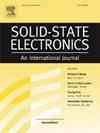Analysis and 3D TCAD simulations of single-qubit control in an industrially-compatible FD-SOI device
IF 1.4
4区 物理与天体物理
Q3 ENGINEERING, ELECTRICAL & ELECTRONIC
引用次数: 0
Abstract
In this study, 3D simulations are introduced to analyze electric-dipole spin resonance (EDSR) for a spin qubit defined in a -node Ultra-Thin Body and Buried oxide (UTBB) Fully-Depleted Silicon-On-Insulator (FD-SOI) device operated at cryogenic temperatures. The device under consideration is designed to be compatible with STMicroelectronics’ standard fabrication techniques. The simulations predict the experimental and device parameters (e.g. drive amplitude, leakage, and Rabi frequency) required to make EDSR a viable means of qubit control before the device is fabricated. This work highlights how 3D TCAD tools which can simulate quantum-mechanical effects can help steer the design of quantum devices.
工业兼容 FD-SOI 器件中的单量子比特控制分析和 3D TCAD 仿真
本研究引入三维模拟,分析了在低温下运行的 28nm 节点超薄体和埋入氧化物(UTBB)全耗尽绝缘体上硅(FD-SOI)器件中定义的自旋量子比特的电偶极子自旋共振(EDSR)。所考虑的器件设计与意法半导体的标准制造技术兼容。模拟预测了实验和器件参数(如驱动振幅、泄漏和拉比频率),这些参数是在器件制造之前使 EDSR 成为一种可行的量子位控制手段所必需的。这项工作凸显了能够模拟量子力学效应的三维 TCAD 工具如何帮助指导量子器件的设计。
本文章由计算机程序翻译,如有差异,请以英文原文为准。
求助全文
约1分钟内获得全文
求助全文
来源期刊

Solid-state Electronics
物理-工程:电子与电气
CiteScore
3.00
自引率
5.90%
发文量
212
审稿时长
3 months
期刊介绍:
It is the aim of this journal to bring together in one publication outstanding papers reporting new and original work in the following areas: (1) applications of solid-state physics and technology to electronics and optoelectronics, including theory and device design; (2) optical, electrical, morphological characterization techniques and parameter extraction of devices; (3) fabrication of semiconductor devices, and also device-related materials growth, measurement and evaluation; (4) the physics and modeling of submicron and nanoscale microelectronic and optoelectronic devices, including processing, measurement, and performance evaluation; (5) applications of numerical methods to the modeling and simulation of solid-state devices and processes; and (6) nanoscale electronic and optoelectronic devices, photovoltaics, sensors, and MEMS based on semiconductor and alternative electronic materials; (7) synthesis and electrooptical properties of materials for novel devices.
 求助内容:
求助内容: 应助结果提醒方式:
应助结果提醒方式:


